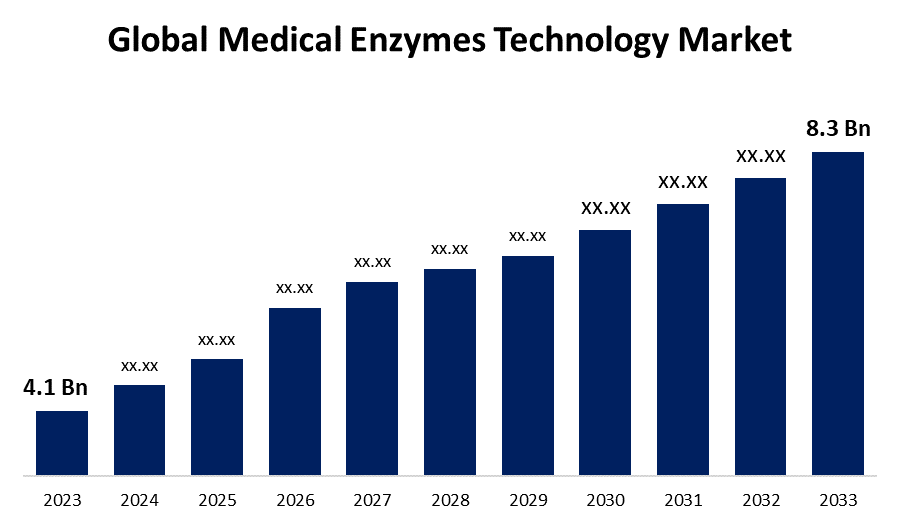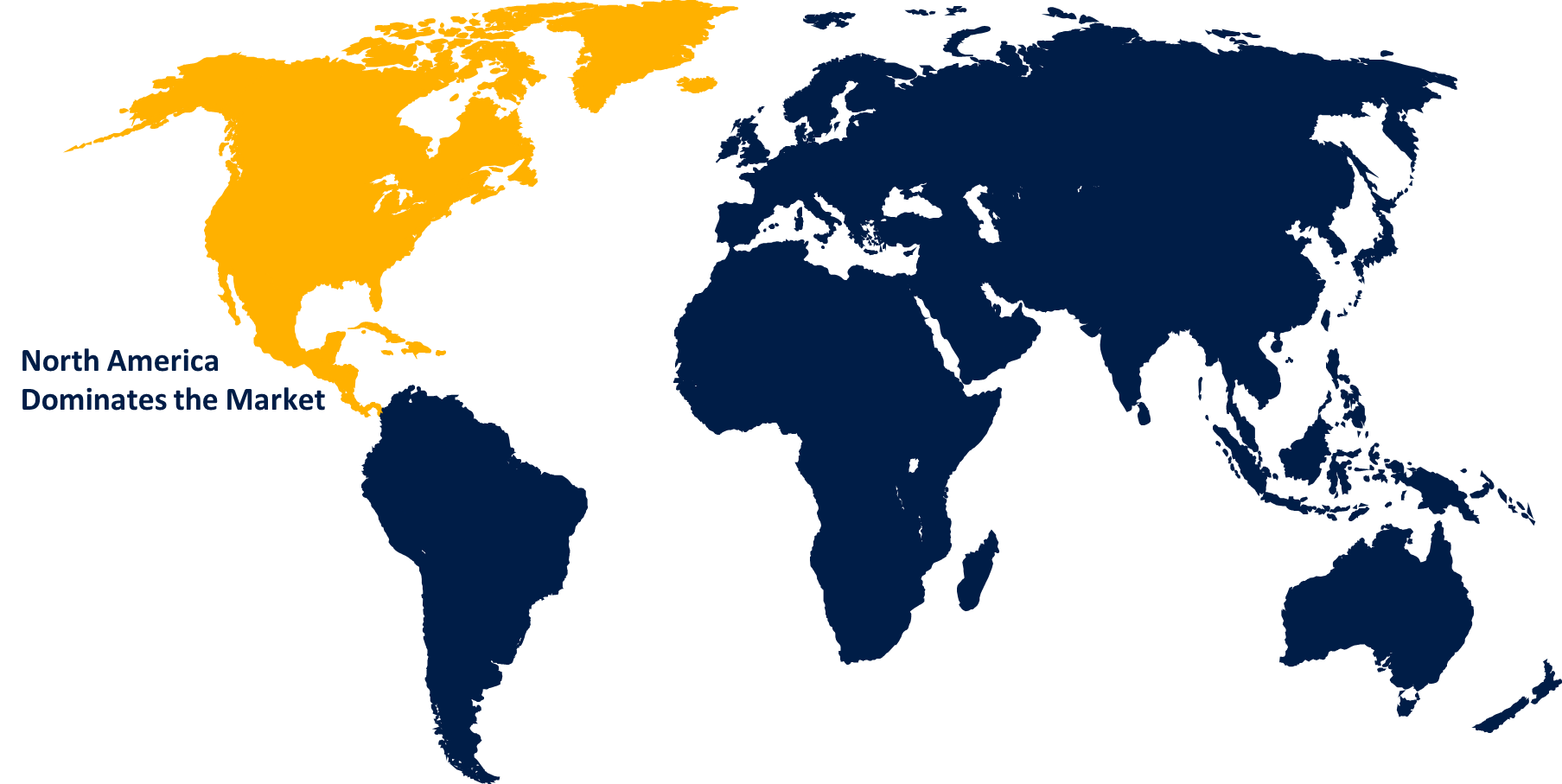Global Medical Enzymes Technology Market Size, Share, and COVID-19 Impact Analysis, By Enzyme (Digestive Enzyme, Thrombolytic Enzyme, Hydrolases, and Others), By Application (Disease Treatment, Diagnostic Tools, and Biomedical Research), and By Region (North America, Europe, Asia-Pacific, Latin America, Middle East, and Africa), Analysis and Forecast 2023 - 2033
Industry: HealthcareGlobal Medical Enzymes Technology Market Insights Forecasts to 2033
- The Global Medical Enzymes Technology Market Size was Valued at USD 4.1 Billion in 2023
- The Market Size is Growing at a CAGR of 7.3% from 2023 to 2033
- The Worldwide Medical Enzymes Technology Market Size is Expected to Reach USD 8.3 Billion by 2033
- Asia Pacific is Expected to Grow the fastest during the forecast period.

Get more details on this report -
The Global Medical Enzymes Technology Market Size is Anticipated to Exceed USD 8.3 Billion by 2033, Growing at a CAGR of 7.3% from 2023 to 2033.
Market Overview
Medical enzyme technology represents the application of enzymes in the identification, medications, and control of ailments. Enzymes are better defined as proteins that accelerate the rate of a biochemical response in the human body. They offer numerous medical applications, which include identification, medication production as well as therapy of medical ailments that involve, though exceedingly not only enzyme defects. They also take part in identifying tests as indicators of blood sugar, liver performance, and even cholesterol, to assist doctors in determining the overall health status of an individual. A case in point is that of glucose oxidase found in blood sugar monitoring for diabetics. In some diseases where the body lacks a specific enzyme, the replacement of the enzymes is required. A typical example of such diseases would be Gaucher's disease or cystic fibrosis. These global medical enzyme technology market enzymes find applications in diagnostics and pharmaceuticals. They also play a fundamental key role in the manufacturing process of drugs, which helps in ascertaining that the synthesis of active ingredients becomes more efficient and friendly to the environment. In ulcer treatment, medical enzymes are used to disintegrate mortified tissues for the stimulation of wound healing. For that reason, the means for such approaches become essential and, therefore, enzymes are diagnostically and therapeutically effective, and tools to boot. Eventually, medical enzyme technology is a key innovation in the contemporary health field and make the line of targeted and minimally invasive treatment more available.
Report Coverage
This research report categorizes the market for the global medical enzymes technology market based on various segments and regions forecasts revenue growth and analyzes trends in each submarket. The report analyses the key growth drivers, opportunities, and challenges influencing the global medical enzymes technology market. Recent market developments and competitive strategies such as expansion, product launch, and development, partnership, merger, and acquisition have been included to draw the competitive landscape in the market. The report strategically identifies and profiles the key market players and analyses their core competencies in each sub-segment of the global medical enzymes technology market.
Global Medical Enzymes Technology Market Report Coverage
| Report Coverage | Details |
|---|---|
| Base Year: | 2023 |
| Market Size in 2023: | USD 4.1 Billion |
| Forecast Period: | 2023 - 2033 |
| Forecast Period CAGR 2023 - 2033 : | 7.3% |
| 2033 Value Projection: | USD 8.3 Billion |
| Historical Data for: | 2019-2022 |
| No. of Pages: | 276 |
| Tables, Charts & Figures: | 110 |
| Segments covered: | By Enzyme, By Application, By Region |
| Companies covered:: | Merck, Thermo Fisher Scientific Inc., Novozymes, TAKEDA PHARMACEUTICAL COMPANY LIMITED, Agilent Technologies, Inc., Danaher (Cytiva), Sanofi, Asahi Kasei Corporation, Promega Corporation, Amano Enzyme Inc, Genzyme Corporation, Cytiva, Sun Pharmaceutical Industries Ltd., F. Hoffmann-La Roche Ltd, Sekisui Chemical Co. Ltd, and Others |
| Pitfalls & Challenges: | Covid 19 Impact Challanges, Future, Growth and Analysis |
Get more details on this report -
Driving Factors
Rising demand, R&D, and awareness boost medical enzyme technology market
Rising demand for low-cost, yet effective medical treatments, as well as rising cancer rates, are expected to drive growth in the global medical enzyme technology market in the coming years. Furthermore, the increasing focus of market players on research and development, as well as growing public awareness of the benefits of these advanced treatment solutions, is driving growth in the global medical enzyme technology market.
Restraining Factors
limited lifespan, immune responses, and monitoring required.
Enzymes present some challenges, including a short in vivo half-life, a lack of targeted action, and, most notably, a patient immune system reaction to the enzyme. As a result, it is critical to monitor serum immune response throughout treatment.
Market Segmentation
The global medical enzymes technology market share is classified into enzyme and application.
- The hydrolases segment is expected to hold the largest share of the global medical enzymes technology market during the forecast period.
Based on the enzyme, the global medical enzymes technology market is categorized into digestive enzymes, thrombolytic enzymes, hydrolases, and others. Among these, the hydrolases segment is expected to hold the largest share of the global medical enzymes technology market during the forecast period. Hydrolase enzymes can accelerate substrate breakage. They also have excellent catalyst effectiveness, and broad substrate specificity, are widely and commercially available, and demonstrate excellent stability. Hydrolase enzymes aid in the treatment of a variety of disorders. Because of their superior properties, hydrolase enzyme products are expected to dominate the global medical enzyme technology market in terms of demand in the forecast years.
- The diagnostic tools segment is expected to grow at the fastest CAGR during the forecast period.
Based on the application, the global medical enzymes technology market is categorized into disease treatment, diagnostic tools, and biomedical research. Among these, the diagnostic tools segment is expected to grow at the fastest CAGR during the forecast period. The global end-use of products from this market is in the diagnostic and pharmaceutical industries. The majority of diagnostic tools used are geared towards therapeutic applications for the treatment of many different kinds of pathological conditions, mostly those stemming from an insufficient level of various kinds of enzymes within the body. It is also used in many of the biotechnology and diagnostic processes, for example, the sequencing and alteration of DNA. A large spectrum of ELISAs and various other reagents for diagnostic testing are produced using medical enzymes.
Regional Segment Analysis of the Global Medical Enzymes Technology Market
- North America (U.S., Canada, Mexico)
- Europe (Germany, France, U.K., Italy, Spain, Rest of Europe)
- Asia-Pacific (China, Japan, India, Rest of APAC)
- South America (Brazil and the Rest of South America)
- The Middle East and Africa (UAE, South Africa, Rest of MEA)
North America is projected to hold the largest share of the global medical enzymes technology market over the forecast period.

Get more details on this report -
North America is projected to hold the largest share of the global medical enzymes technology market over the forecast period. This trend can be attributed to an increase in the incidence of chronic diseases, increased investments by regional players in R&D, and an increase in demand for enzyme replacement therapies. Additionally, the presence of a large number of well-established players contributes to the growth of the North American medical enzyme technology market.
Asia Pacific is expected to grow at the fastest CAGR growth of the global medical enzymes technology market during the forecast period. Growing public awareness, milestone achievements in biotechnology research, and increasing acceptance of new technologically advanced solutions and advancements in medical technology are some of the key drivers of this market. Also, rising pharmaceutical output from regional manufacturers is driving growth in the Asia Pacific medical enzyme technology market.
Competitive Analysis:
The report offers the appropriate analysis of the key organizations/companies involved within the global medical enzymes technology market along with a comparative evaluation primarily based on their product offering, business overviews, geographic presence, enterprise strategies, segment market share, and SWOT analysis. The report also provides an elaborative analysis focusing on the current news and developments of the companies, which includes product development, innovations, joint ventures, partnerships, mergers & acquisitions, strategic alliances, and others. This allows for the evaluation of the overall competition within the market.
List of Key Companies
- Merck
- Thermo Fisher Scientific Inc.
- Novozymes
- TAKEDA PHARMACEUTICAL COMPANY LIMITED
- Agilent Technologies, Inc.
- Danaher (Cytiva)
- Sanofi
- Asahi Kasei Corporation
- Promega Corporation
- Amano Enzyme Inc
- Genzyme Corporation
- Cytiva
- Sun Pharmaceutical Industries Ltd.
- F. Hoffmann-La Roche Ltd
- Sekisui Chemical Co. Ltd
- Others
Key Market Developments
- In March 2024, Axxess XY was officially introduced at Victam in Bangkok. W Nutrition claims that its xylanase product positions it at the forefront of enzyme technology innovation in animal nutrition.
- In December 2022, Ginkgo Bioworks announced the launch of Ginkgo Enzyme Services. Ginkgo Enzyme Services is based on ultra-high throughput screening, machine learning-guided protein design, and optimized proprietary bacterial and fungal host strains.
Key Target Audience
- Market Players
- Investors
- End-users
- Government Authorities
- Consulting And Research Firm
- Venture capitalists
- Value-Added Resellers (VARs)
Market Segment
This study forecasts revenue at global, regional, and country levels from 2020 to 2033. Spherical Insights has segmented the global medical enzymes technology market based on the below-mentioned segments:
Global Medical Enzymes Technology Market, By Enzyme
- Digestive Enzyme
- Thrombolytic Enzyme
- Hydrolases
- Others
Global Medical Enzymes Technology Market, By Application
- Disease Treatment
- Diagnostic Tools
- Biomedical Research
Global Medical Enzymes Technology Market, By Regional
- North America
- US
- Canada
- Mexico
- Europe
- Germany
- UK
- France
- Italy
- Spain
- Russia
- Rest of Europe
- Asia Pacific
- China
- Japan
- India
- South Korea
- Australia
- Rest of Asia Pacific
- South America
- Brazil
- Argentina
- Rest of South America
- Middle East & Africa
- UAE
- Saudi Arabia
- Qatar
- South Africa
- Rest of the Middle East & Africa
Frequently Asked Questions (FAQ)
-
1. What is the CAGR of the global medical enzymes technology market over the forecast period?The Global Medical Enzymes Technology Market Size is Expected to Grow from USD 4.1 Billion in 2023 to USD 8.3 Billion by 2033, at a CAGR of 7.3% during the forecast period 2023-2033.
-
2. Which region is expected to hold the highest share in the global medical enzymes technology market?North America is projected to hold the largest share of the global medical enzymes technology market over the forecast period.
-
3. Who are the top key players in the medical enzymes technology market?The top key players in the global medical enzymes technology market are Merck, Thermo Fisher Scientific Inc., Novozymes, TAKEDA PHARMACEUTICAL COMPANY LIMITED, Agilent Technologies, Inc., Danaher (Cytiva), Sanofi, Asahi Kasei Corporation, Promega Corporation, Amano Enzyme Inc, Genzyme Corporation, Cytiva, Sun Pharmaceutical Industries Ltd., F. Hoffmann-La Roche Ltd, Sekisui Chemical Co. Ltd, and Others.
Need help to buy this report?